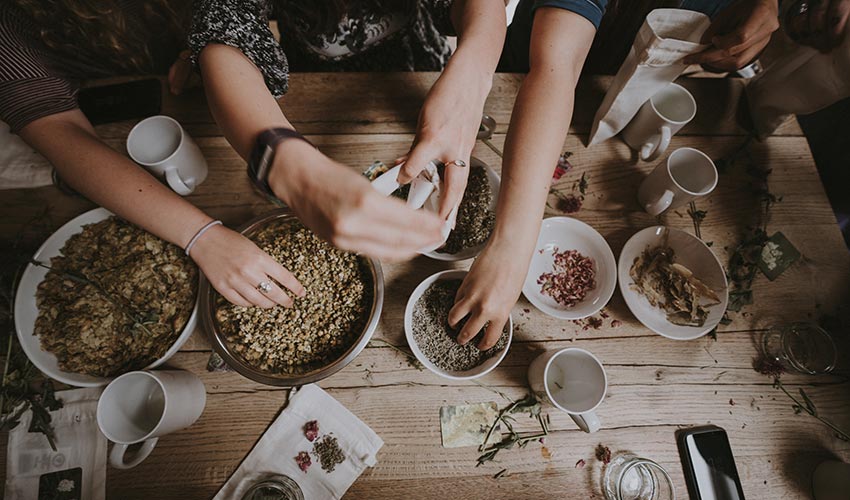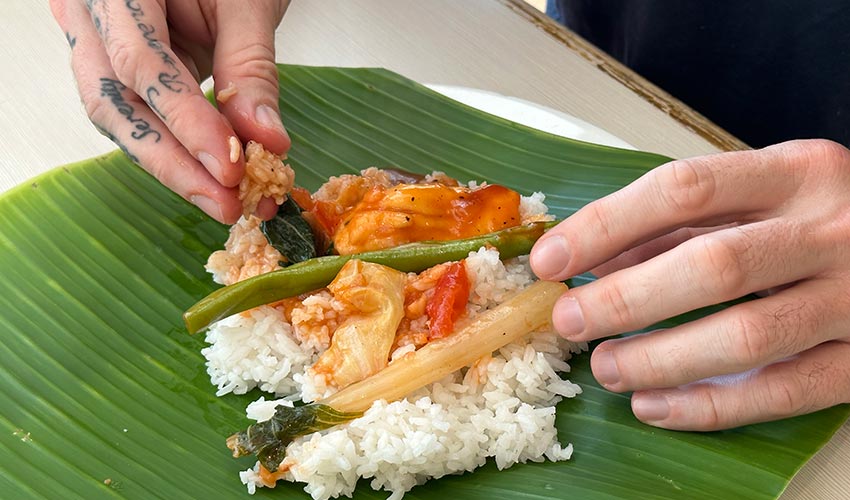Eat with Your Hands for Better Health
Oh, be still my beating heart! I simply cannot contain my excitement about penning an ode to the wonders of manual dining, or shall we say, the enchantment of analog dining – if you can handle that level of sophistication. Picture this: the year was 2003, and I embarked on an extraordinary journey to foreign lands. Little did I know, my peculiar preference had suddenly become the standard of excellence. I always loved to eat with my hands and it felt natural to me. Due to my many travel experiences, I realised it was natural to a huge portion of the world. But over the years I noted on why, why is it good for us? In our diverse world, various regions boast unique culinary traditions that extend beyond the food itself to the manner of consumption. One such tradition, regrettably fading amidst modern dining habits, involves eating with one's hands. Countries like India, Ethiopia, the Middle East and The Philippines (which coincidentally is where I am now) regard this practice as more than a mere eating method; it's a vital component of cultural heritage, showcasing a distinct skill unattainable through cutlery. In fact it was eating with my hands here in the mountains of Baguio, Philippines that made me want to put this article all together. On the article photo you can see me eating a very unusual food of the Philippines... Balut.
While spoons, forks, and knives have become ubiquitous globally, often associated with practicality or refinement, many individuals steadfastly adhere to the age-old custom of eating with their hands. Notably, this cultural practice might not only offer emotional but also substantial health benefits. Recent research unveils a fascinating aspect of this enduring tradition: its notable health advantages. Studies suggest that dining with hands may contribute to better digestion, promote mindful eating, and enhance overall well-being. This challenges the notion that newer methods are inherently superior. Is this once again going to be time for a line all over the Ancient Purity site? yes... Science is catching up with nature. As we delve deeper into this topic, reconsidering our eating habits becomes worthwhile; foregoing cutlery in favour of a health-oriented perspective may prove beneficial.

The Cross-Cultural Tradition of Manual Dining
Eating with one's hands stands as a time-honored tradition deeply embedded in the cultures of diverse societies. Beyond serving as a mere means of consuming food, this practice fosters a profound connection to cultural identity and communal history. In various parts of Africa, such as Ethiopia and coastal West African nations, tactile engagement with food forms an integral part of the dining experience, intertwining each bite with a collective past. Similarly, in South Asia, using hands during meals represents a natural extension of the dining ritual, imparting a personal touch that establishes an emotional link to one's food. These traditional dining customs, passed down through generations, carry rich historical significance, embodying values of humility, community, and life's simple pleasures—lessons often inherited from family elders. Each shared meal serves as a continuation of this cultural legacy.
Yet, in today's globalised society, conventional customs often yield to standardised practices, with cutlery gaining prevalence and overshadowing traditional methods. This shift transcends mere changes in eating habits; it signifies an evolution in cultural norms. Despite the influence of standardised etiquette portrayed in media and contemporary dining settings, many young people are drawn to utensils. Nevertheless, the fundamental act of eating with hands persists, demonstrating the enduring power of cultural identity amid evolving times.

The Benefits of Eating with our Hands
Fosters Mindful Eating: Dining with your hands cultivates a heightened awareness of both your food and eating pace. This mindfulness not only enhances the overall enjoyment of the culinary experience but also serves as a natural deterrent against overeating. Engaging physically with your food grounds you in the present moment, a practice identified by studies as effective in preventing binge eating disorders and compulsive overeating.
Supports Digestive Well-being: The hands harbor a diverse array of beneficial bacteria, contributing to a healthier microbial environment. Research indicates that the advantageous bacteria on the skin can potentially combat harmful intestinal flora and pathogens, thereby promoting better digestion. However, it's imperative to emphasize thorough handwashing before meals to introduce only beneficial bacteria to the gut.
Promotes Portion Control: Psychologically, hand-eating is linked to consuming smaller portions due to increased consciousness of the eating process. The tactile act of picking up food naturally heightens sensitivity to the body's hunger and satiety signals, supported by research on consumption and cognitive processing.
Maintains Joint Flexibility: The fine motor skills involved in using hands and fingers for eating contribute to maintaining flexibility in the joints. Though a subtle activity, it proves effective, particularly for individuals interested in preserving the agility of their hands and fingers.
Boosts Immune Function: Research published in the Journal of Applied Microbiology suggests that exposure to environmental microbiota is vital for building a balanced immune system capable of resisting infections. Consuming food with clean hands introduces trace amounts of bacteria, potentially aiding in developing resistance to harmful microbes.
Enhances Psychological Well-being: Hand-eating goes beyond physical nourishment, contributing positively to psychological health. Occupational therapy research indicates that the tactile engagement associated with hand-eating can be comforting and foster feelings of contentment. This direct contact with food can help alleviate stress, providing a sense of satisfaction beyond the taste and nutritional value of the meal. The hands-on experience encourages a mindful eating practice, potentially making each meal more gratifying and calming.

Dispelling Misconceptions Surrounding Hand-Eating Practices
Although you can see eating with hands is a widespread tradition observed in various cultures globally, it often faces unwarranted criticism, primarily fuelled by hygiene concerns. This traditional method involves direct contact with food, presenting a distinctive experience compared to the use of conventional utensils like forks, knives, and spoons prevalent in many societies. I never had a problem with this method and I'm going to put together the answers to the concerns to the common misconceptions.
Unclean Perception: There's a prevalent misconception that hands are inherently dirty due to their contact with various surfaces, rendering them unsuitable for eating.
Uncivilised Stereotype: Eating with hands is sometimes unjustly labeled as backward or lacking cultural refinement, overlooking its profound cultural significance across the globe. Even people I met who claimed to be so in touch with nature found it and I quote "gross" to eat with hands. We need to get over this sanitised view of life.
Health Risks Assumption: This is maybe the most common should have put it top. There's a belief that opting for hands over utensils increases the risk of illnesses, often disregarding the crucial role of proper hand washing in maintaining hygiene.
Let me now share some Factual Insights
Control Over Cleanliness: Contrary to the unclean perception, the argument about hygiene falls short when considering the effectiveness of proper hand-washing. Cultures that traditionally embrace hand-eating often incorporate rigorous hand-washing practices before meals, ensuring a level of cleanliness that rivals the use of utensils.
Cultural Value: The notion that eating with hands is a primitive or uncultured practice misses the mark. Instead, it is a significant cultural tradition that involves an intentional skill, fostering a sense of community and respect for the food being consumed. It serves as a rich tapestry woven into the fabric of diverse societies.
Safety in Hygiene Practices: Dismissing hand-eating as unhealthy fails to acknowledge that utensils, too, can harbor germs. When hands are washed correctly, they can potentially be more hygienic, as individuals have direct control over ensuring their cleanliness. Proper hand hygiene is a universal practice that transcends the method of food consumption.
By unraveling these misconceptions and shedding light on the facts, we can appreciate hand-eating as not just a practical dining method but a culturally significant and hygienically sound tradition, inviting a broader perspective on the diversity of culinary practices around the world.

The Art of Hand-Eating: Essential Tips for Beginners
Come fly out to the Philippines and meet me, I'm around. If that's not suitable just start on the journey right where you are. Eating with your hands may initially present itself as a challenge, especially for newcomers. However, with a few practical tips, you can seamlessly adapt to this cultural practice. Here's a comprehensive guide to help you navigate and fully embrace this enriching culinary experience:
Prioritise Hand Hygiene: Before you begin your hand-eating adventure, meticulously wash your hands with soap and water. This act not only maintains cleanliness but also serves as a revered ritual in cultures that advocate eating with hands.
Opt for the Right Hand: In many cultural contexts, using the right hand is not just customary but also polite. The left hand is traditionally considered unclean and reserved for hygiene purposes. Follow the lead of those around you to ensure respectful participation. Also whenever handing or receiving money it's best to use the right hand, sorry lefties.
Mind Your Portions: Exercise moderation by avoiding large portions. Instead, take small, manageable amounts that you can comfortably consume in one or two bites. This practice aligns with the ethos of ease in eating and demonstrates respect for the food, minimising wastage.
Gentle Fingertip Mastery: Use your fingertips with finesse when picking up food, this one took me a while to get right, I learned by observation. There's no need for an entire hand scoop; be delicate and convey the food to your mouth, tilting your head slightly forward to prevent spillage.
Savour the Experience: Resist the urge to rush through the meal, it's so rewarding, one line over and over I say to myself on everything is... Slow Down. Hand-eating is an unhurried process designed for savouring the flavours and experiences of the food. Many believe that direct hand-to-food contact enhances the overall enjoyment.
Observe & Learn: When in a cultural setting that embraces hand-eating, keenly observe those around you. Learn the nuances, such as the proper way to mix your food or how to handle bread. Observing provides valuable insights for a seamless dining experience.
Immerse Yourself in the Moment: Relax and fully engage in this new culinary adventure. Eating with your hands offers a distinctive connection with your food—feel the textures, appreciate the temperatures, and immerse yourself in the present moment.
Uphold Table Manners: Just as with utensil dining, adhere to etiquette when eating with your hands. Avoid licking your fingers, refrain from reaching across the table, and resist the urge to talk with your hands full.
Post-Meal Hand Hygiene: Upon completing your hand-eating experience, demonstrate politeness and hygiene by washing your hands once again. Some establishments may provide a bowl of lemon water at the table for a refreshing post-meal rinse.

Thanks for reading this, it's something that is close to my heart and I really believe in. It transcends being a mere alternative; it unfolds as a gateway to numerous health advantages and a deeper connection to cultural heritage. It extends beyond the act of forgoing utensils; it encompasses an appreciation of the cultural significance of food and the associated traditions. Ignore all those negative, lower consciousness beings who talk about cultural appropriation, this is our world, the world is our home, happy, friendly people across the globe want you to sit and enjoy food with them, often they'll laugh as you do things of their culture, it's what makes travelling and the world so fun. Forget anyone who stares and judges, they're jealous they're too uptight to enjoy it.
In health terms you can see this is powerful. So for those venturing into this practice for the first time, hand-eating proves transformative. It offers an opportunity to break free from established eating habits, fostering a more intimate interaction with food and instilling mindfulness at the dining table. This approach encourages a more engaged and reverential attitude toward meals, highlighting the diverse cultural tapestry of the world. Consider setting aside the cutlery for your upcoming meal and relish a hands-on experience, forging a direct and meaningful connection with your food. By incorporating these tips into your hand-eating practice, you'll not only navigate this cultural tradition with finesse but also uncover a more profound connection to your food and the diverse culinary practices embraced worldwide. So go forth and enjoy this new practice I can't recommend it enough.






















